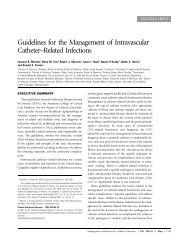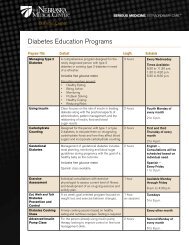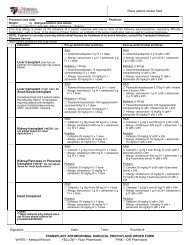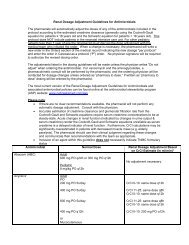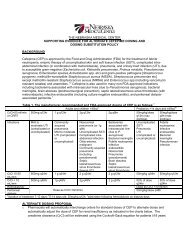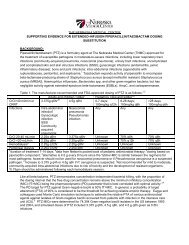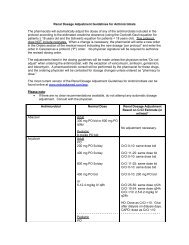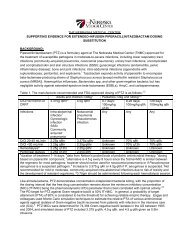Clostridium difficile Infection (CDI) - The Nebraska Medical Center
Clostridium difficile Infection (CDI) - The Nebraska Medical Center
Clostridium difficile Infection (CDI) - The Nebraska Medical Center
Create successful ePaper yourself
Turn your PDF publications into a flip-book with our unique Google optimized e-Paper software.
hypotension, shock, toxic megacolon, and fulminant colitis. In cases with these complications both thegastroenterology and infectious disease service should be consulted and a regimen combining both oralvancomycin and intravenous metronidazole is recommended. Early colectomy can be life saving inpatients with severe disease. Little data exists to guide treatment in refractory disease. If <strong>CDI</strong> recursafter treatment, the same agent used to initially treat the infection should be used again for 10 days. Iffurther relapses occur, vancomycin should be used as prolonged courses of metronidazole have beenassociated with neurotoxicity.Isolation:Vigilant hand washing, isolation precautions, and environmental cleaning are keys to controlling C.<strong>difficile</strong>. All patient care areas will use the same procedures for testing, treatment and isolation.Universal glove use, the use of gowns for any substantial patient or environmental contact, and handhygiene with soap and water are key components to controlling the spread of C. <strong>difficile</strong>. Patients with anegative GDH and toxin assay do not need to be isolated. Patients with GDH positive, toxin negativestools may or may not have <strong>CDI</strong>. If patients have any symptoms consistent with <strong>CDI</strong> (i.e. diarrhea, fever,abdominal pain) they should remain in isolation as if they had a positive toxin assay. If patients with thisresult are completely asymptomatic (no diarrhea) then there is no need for isolation. Patients with <strong>CDI</strong>will remain in isolation for 1 week after treatment is completed and they are asymptomatic (nodiarrhea).For more information regarding any of these topics please refer to our recently revised guidelines andtreatment pathway at: www.nebraskamed.com/asp.Example Cases:Case #1: A 68 year-old male is admitted with community-acquired pneumonia. He is started onpiperacillin/tazobactam. On hospital day 2 he develops diarrhea. 3 stools are ordered and sent for C.<strong>difficile</strong> and all are negative for both GDH and toxin. Diarrhea resolves when piperacillin/tazobactam ischanged to ceftriaxone. Routine ordering of multiple C. <strong>difficile</strong> assays is unnecessary.Case #2: A 46 year-old female is admitted from home with diarrhea. Her only risk factor is receipt of asingle dose of prophylactic cefazolin 2 weeks ago during an orthopedic procedure. She has a stoolpositive for both GDH and toxin, is started on metronidazole, and improves. Any antibiotic can place aperson at risk for <strong>CDI</strong>.



